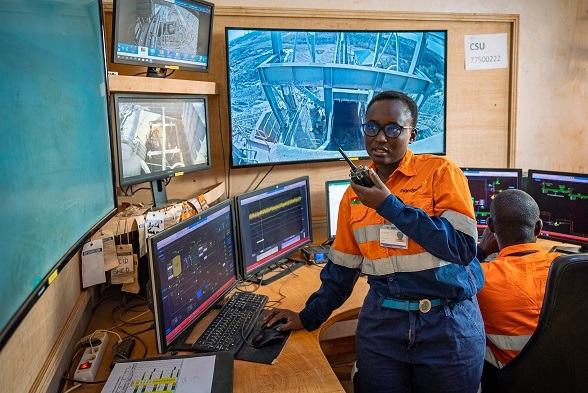Egypt’s retail scene has barely changed in decades; but that hasn’t stopped Procter & Gamble from trying to help modernise from within, as Alan Swaby learns.
It’s hard to imagine many homes in the West that don’t have at least one product from the Procter & Gamble (P&G) stable. Across the three business development areas of beauty and grooming, health and well-being, and homecare, P&G has over 300 different brands bought and used by over four billion people worldwide.
And since the establishment of P&G in Egypt in 1986, the message has been spread across wide swathes of Africa, the Middle East and into Asia. Not all of the 300 brands are available from Cairo—in fact, P&G concentrates on just 18 of the most popular products, including Ariel detergent, where the Egyptian factory has become the main producer for all of the Middle East.
Next year the company will celebrate its 25th anniversary; and the development of the business is nothing short of remarkable. With an initial capital of just US$2.1 million and two brands—Camay and Crest—P&G’s investment has grown over 100 fold. Even more remarkable is that P&G Egypt is now the country’s biggest exporter of packaged goods and one of Egypt’s top exporting companies dealing with more than 37 countries in Africa, Asia and Europe.
What began with 50 employees has grown to around 1,200 and all but a handful are Egyptian nationals. In fact, the last two general managers in Cairo have been Egyptian and more than 35 home grown mangers have gone on to leading positions in P&G worldwide.
At the heart of the process is a 120,000 square metre factory (actually five mini-factories) featuring the largest synthetic detergent tower of its kind in the Middle East where Ariel is made. Productivity at the plant has continued to meet all targets and has encouraged production to the extent that a second plant twice the size of the first is being built just four kilometres away.
It marks a huge step up in P&G’s investment in the Near East. Whereas EGP1.9 billion was invested in the first 24 years of operation, EGP1 billion is being invested in the next three years alone. With 250,000 square metres of new capacity, it will effectively triple production capacity in Cairo. Initially the facility will exclusively produce Pampers nappies and won’t be finally completed until 2020, but it will come on stream next year, employing a further 500 or more staff.
“In the overall context,” says Ramez Farag, external relations manager, “it won’t make much of a dint in Egypt’s unemployment figures but it will send a message to the wider community. The present government is making great strides in attracting new business to Egypt and we want to lead by example.”
There are now 80 multinationals in Egypt and the P&G plant has itself attracted five new investments as P&G suppliers open local operations to feed the factory.
Unemployment can vary from nine per cent to 20 per cent or more, depending on whose figures you believe, but that doesn’t tell the whole story. Even among those with supposedly regular employment, significant levels of disposable income are low, making it difficult for all discretionary purchases. Compared to a virtual 100 per cent penetration in Europe, no more than one in five of the Egyptian population have tried disposable nappies.
It’s a developing country but the retail scene is still more traditional than modern. “There are international retailers operating here,” says Farag. “Carrefour, for example, and from last month, Metro Cash & Carry. But supermarkets account for no more than 13 per cent of the retail market. The vast majority goes through kiosks or small retail stores, of which Egypt has some 270,000!”
The lack of disposable income and the retail structure of the country are not conducive to rapid adoption of western shopping patterns. Nor do poor transport links and inadequate infrastructure help. The seven distributors who buy and sell on P&G products are doing their best; but Farag estimates that they directly cover no more than half the total retail outlets.
Surprisingly, perhaps, P&G’s US parentage seems not to play a great role. “Occasionally,” says Farag, “at times of tension, there is talk of boycotts but this business has a very local face and is seen to be contributing to the overall welfare of the population. We are showing that commercially driven decisions can have a meaningful social impact.”
One such programme is the Mokattam Non-formal Education Project, also known as the recycling school. Mokattam is a Cairo slum and home to one million scavengers who scour the waste dumps for any item of value. Children are forced to help their parents and consequently miss out on schooling. When P&G became aware that discarded shampoo bottles were being cleaned up and then passed off as genuine products, it developed a novel solution to deter the bootleggers and give young children an education.
Surrendering old bottles earns credits to attend school. By linking basic skills to recycling activities, children are taught to count (the number of bottles returned); to read (the labels on the bottles); do calculations (the value of what they’ve recycled); and even computer skills so that the data can be presented on a spreadsheet.
Since 1837, P&G has worked to a set of principles and values aimed at improving life for its customers. It takes its social responsibilities seriously and perpetually develops partnerships aimed at improving the lives of the next generations. Among others, it supports programmes that provide valuable vitamin supplements and pure water to children.
In 2009, P&G was recognised as one of the best ten employers in the Middle East by international HR consultants Hewitt Associates and it holds the prestigious National Award for Excellence in Quality, awarded by Ministry of Trade and Industry's Industrial Modernization Centre.
Behind the scenes, it applies similar thinking to sustainable methods of operating. The new Pampers plant, for example, will aim to recycle all rejected nappies by reducing them to their constituent parts and reusing the raw materials while detergents are being made in concentrated form—reducing volume and all the associated costs that follow.
Future progress for P&G will be linked with the fortunes of the country as a whole; but it has demonstrated that the right level of investment can make a return and a valuable contribution. www.pg.com













